
This post ends with a quiz and more than 49 $5 Starbucks card winners for correct answers. Why the quiz for this post? Because the subject is power factor. Most descriptions of power factor remind me of riding the NYC subway many years ago before passengers buried their faces in their smartphones, which did not yet exist. Instead, choices included looking at the floor or the ceiling, like riding an elevator. God knows you don’t want to make eye contact with the person sitting across from you. At the ceiling were ads for the most socially undesirable products imaginable: cures for toenail fungus, varicose veins, bunions, hemorrhoids, and warts. Power factor belonged with those subjects, until today, my friends.
What the Heck is Power Factor?
Direct Current
Let’s start with direct current (DC) power. A battery produces direct current, and therefore, a DC-powered device plugged into the wall has a brick of sorts to convert alternating current (AC) power to DC power to charge the battery/power the device. Examples include computers, phones, and task lighting like LED or 12V halogen.
Mathematically, DC power is easy:
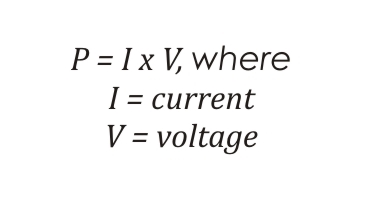
The popular analogy for explaining electricity is to compare electric current to water flowing through a pipe or hose. Voltage is represented by pressure provided by a pump or water tower (elevation). The water flow represents the electrical current. When you provide resistance to water flow with your thumb at the end of a hose, the pressure increases and flow decreases. The same thing happens with electricity, except in a simple case, the resistor might be a toaster coil or incandescent light bulb.
We just established that voltage drives current. If that is too hard to follow, quit here because you have no chance of passing the quiz.
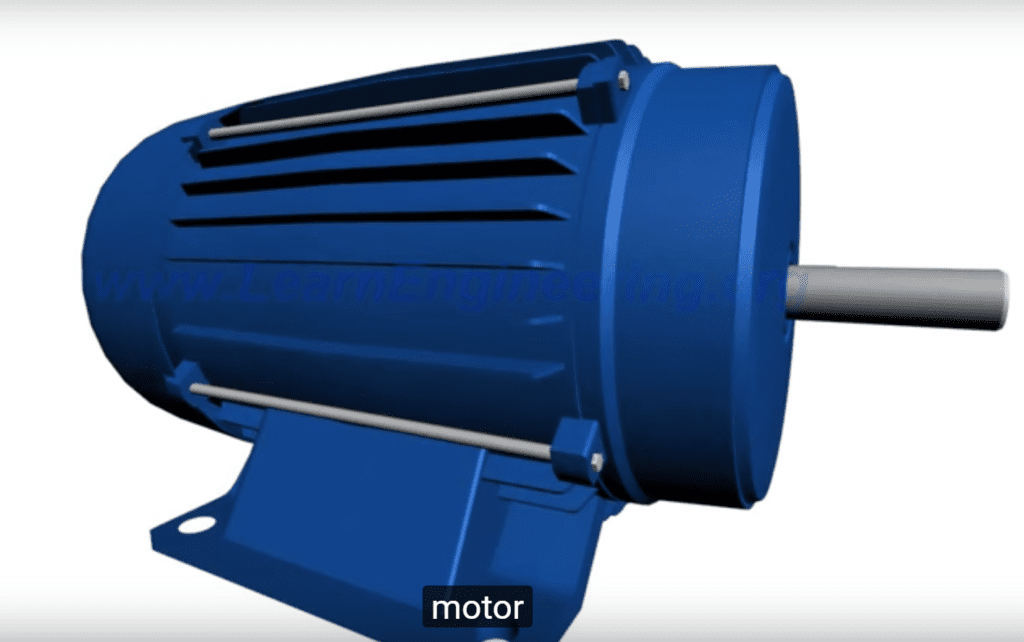
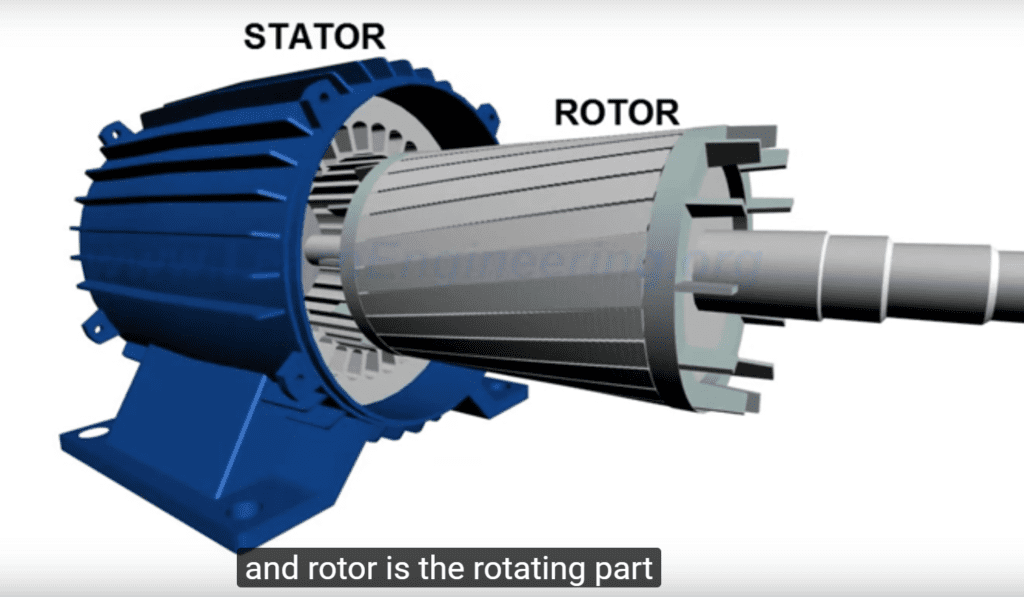
Alternating Current
Alternating current gets a lot messier to explain, especially when inductive loads are considered. What is an inductive load? Most simply, an AC motor, shown below. This is a three-phase motor. You will only see these in commercial and industrial buildings because homes only get single phase power.
Why is it inductive? That is an awesome question. Because current in a coil induces a magnetic field, as described last week. When the coils in the stator are hit with three-phase alternating current, something wonderful happens; the magnetic field rotates all by itself. What genius figured this out? It’s a good idea to click the image above and watch the video, but if you are subject to motion sickness, you might want to pop some Dramamine when the “simplified” theory part comes on.
Going Deep
As the video explains, rotor/shaft speed never keeps up with the invisible spinning electric field. Once torque[1] is applied, slip begins. Even an unloaded motor with nothing connected to the shaft requires some torque to rotate.
I’m going to go out on a limb and say slip is a result of the second law of thermodynamics, that is, every process has unavoidable losses that end up as heat that must be dissipated, as the video explains. Slip is similar to spinning tires on ice. Spinning tires generate heat. which melts ice (virtually frictionless). So don’t spin!
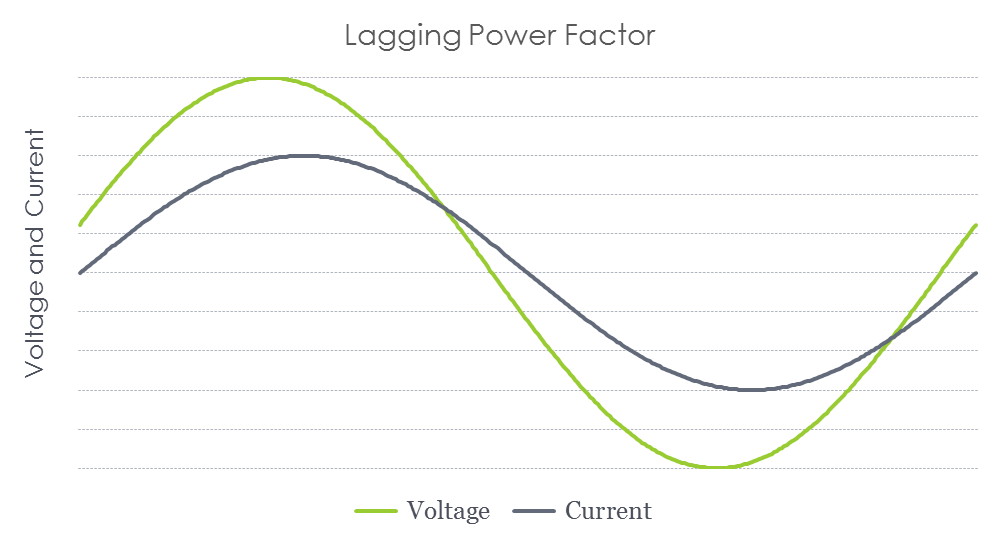
Lagging Power Factor
Leading and Lagging
As described above, voltage induces current. Therefore, in an alternating current of wave motion, voltage leads current because I said so. This is depicted in the cartoon below. Pay no attention to the magnitude (vertical), only the phase (horizontal). Since we are used to “leading” being in front from left to right, it might appear that current is “leading.” No. The horizontal axis is time, and the voltage hits its peak before current does, so current lags. This is normal lagging power factor.
Why does it lag? Second law of thermodynamics, as power travels long distances, but also due to funky loads.
Stored Energy
Electricity is a little like faith to me. When current alternates in a full cycle (one cycle is shown in the cartoon above), sixty times a second, and motors spin 29.8 times per second, all physical analogies go out the window for me. However, Wikipedia tells me motors store some energy in the form of mechanical spinning energy, and then put it back on the wire. Motors are generators too.
Lightly loaded motors turn at higher speeds with less slip relative to the invisible spinning field. However, this creates more stored and released energy. Why? Because it bounces around in the magnetic field more. Consider my linear motor demonstration below (click image to watch video), where my hand is the power supplied to the driving magnetic field, and the clippy clamp rotor moves in relation.
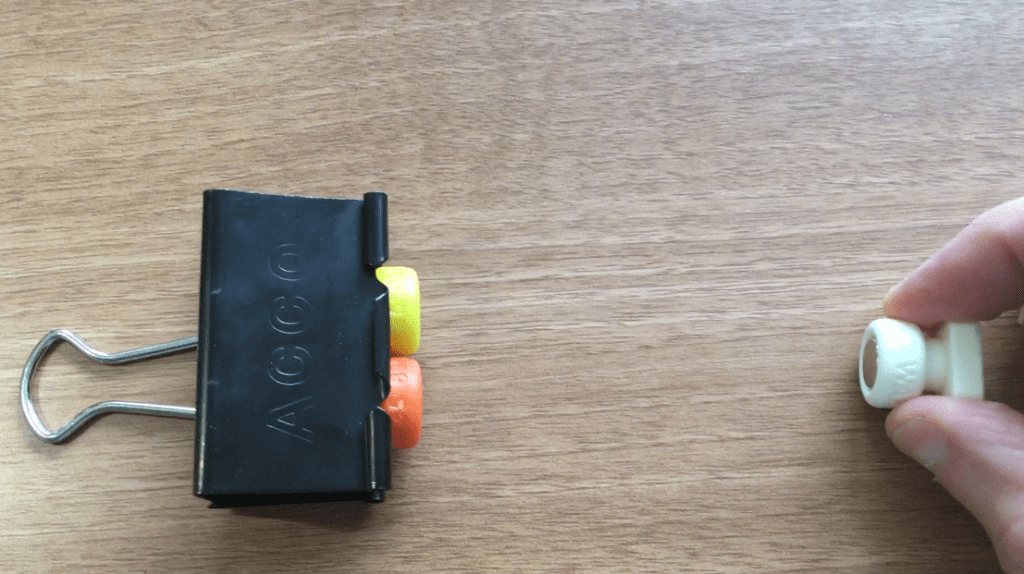
You can see when it is unloaded, it stores energy and “bounces”. When it is loaded, it does not bounce as much.
Therefore, a leading cause of lousy power factor is bouncing, lightly loaded motors.
I will follow up next week with why this all matters and what to look for in buildings with lousy power factor.
Quiz Rules
There are three questions, and everyone has a good chance of winning because I make cool rules. If I hear “I didn’t think I was eligible”, you get a $20 fine. Winners will be picked via this hierarchy:
- The most correct answers
- The fastest to respond
The number of winners who are engineers will be limited. If you are not an engineer, you are likely better off anyway.
Non-engineers must prove they are not engineers, and that they did not get help from Russian hackers.
Michaels’ employees are eligible for a limited slot of winners.
Quiz Instructions
- Send your responses to info@michaelsenergy.com
- Indicate whether or not you have an engineering degree
- Provide first and last name if it isn’t obvious from your email address. It will be kept confidential. We just want to know who the cool people are.
- Submit responses by 11:59 pm CST, Friday, March 10. Winners will be notified Monday, March 13.
Quiz:
- Name one source of heat generated in an operating motor.
- What does a three-phase induction motor require to start?
- What do my kids have?
[1] Torque is a rotational force like that required for an electric mixer to mix cookie dough.
